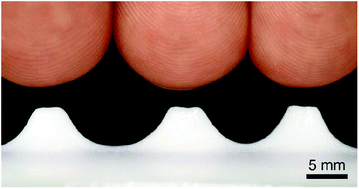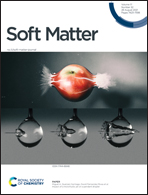Agile reversible shape-morphing of particle rafts†
Abstract
Materials that transform shapes responding to external stimuli can bring unprecedented innovations to soft matter physics, soft robotics, wearable electronics, and architecture. As most conventional soft actuation technologies induce large deformations only in a preprogrammed manner at designated locations, the material systems capable of agile reversible deformations without prescribed patterns are strongly desired for versatile mechanical morphing systems. Here we report a morphable liquid interface coated with dielectric particles, or a particle raft, which can reversibly change its topography under an external electric field. The rafts change from flat floors to towers within seconds, and the morphed structures are even capable of horizontal translation. Our experiments and theory show that the raft deformation is driven by electrostatic attraction between particles and electrodes, while being modulated by electric discharge. A broad range of materials serving as electrodes, e.g., human fingers and transparent polymers, suggests this system's diverse applications, including the human–machine interface and the three-dimensional physical display.

- This article is part of the themed collection: Soft Matter Editor-in-Chief's Choice


 Please wait while we load your content...
Please wait while we load your content...